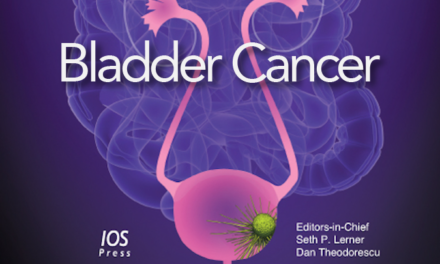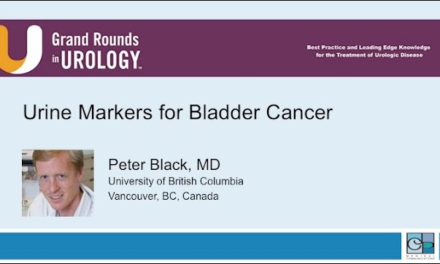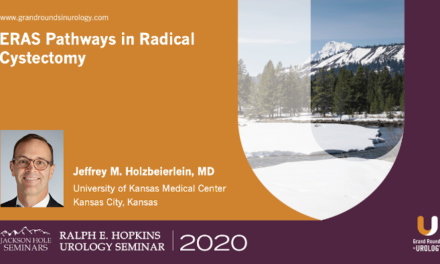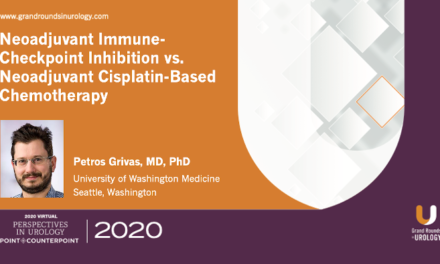Erik P. Castle, MD presented the pro argument for “BCG Maintenance — Full SWOG Course” at the 26th Annual Perspectives in Urology: Point-Counterpoint, November 10, 2017 in Scottsdale, AZ
How to cite: Castle, Erik P. “BCG Maintenance — Full SWOG Course” November 10, 2017. Accessed Dec 2024. https://dev.grandroundsinurology.com/bcg-maintenance-full-swog-course-pro/
Summary:
Erik P. Castle, MD, explains the Southwest Oncology Group’s (SWOG’s) protocol for administering maintenance doses of bacillus Calmette-Guerin (BCG) to non-muscle invasive bladder cancer patients. He argues that carrying out the full SWOG course makes a positive impact on patients’ recurrence free survival rates, and describes which disease types and patients should ideally receive the full course. This is a counter argument to Michael S. Cookson’s “BCG Failure: BCG Maintenance Should be Less Intense.”
BCG Maintenance — Full SWOG Course – Pro Argument
Transcript:
So I’ve been given the task of—you know, we’ve got the debate here, and these are always the fun ones, but this—unfortunately I’ve been given the easy part, which is supporting what we all—most of us are practicing, which is the full SWOG course. We will make this pretty quick. You’ve heard a lot of it already from Dr. Cookson, so we’ll kind of—unfortunately I have no financial disclosures.
So I’ll briefly review the SWOG course. I’m not going to do too much because this has already been reviewed by Mike, and, you know, then the next question is, you know, guidelines, what’s recommended, white papers, and it’s real easy to sit in a committee and say what everybody should be doing because you might have your practice, your environment in an academic institution or ivory tower, and then other people have other things and other considerations, and patients are different, and they are not all the same, and there’s a lot of things that a lot of these studies haven’t controlled for, and we will briefly talk on that. So I think knowing what really happens is another issue. What really is going on for all of these patients, and their ability to get back to the office and things like that. Ultimately, I am going to share with you that I am a believer in BCG because I think it’s really one thing or the other. Either BCG works or it doesn’t work. It’s one or the other. I don’t buy into there is kind of an in between road. Either patients have an immune system that is going to respond appropriately or they don’t. Some of you have maybe been at this course before and have seen some of the basic work we’ve done showing that, you know, we—and really this is now supported by all of the PDL1 and PD1 work that is being done demonstrating that either your immune system is ready to be primed or it isn’t.
So the classic, you know, SWOG study that was published in I think it was published in 2000 that was headed up by a large group of well-known bladder cancer experts and in particular Don Lamm, I don’t know if he is here today, he often comes to this meeting, was the “Connaught” strain. The bottom line was you got induction BCG, and then you had it at 3, and the induction was once a week for six weeks, and then you had once a week for three weeks at 3, 6, 12, 18, 24, 30, and 36 months, and it’s once a week for three weeks. There are variations on that because ultimately what you are getting is essentially three years, every three months for the first roughly first year, and then every six months for the remaining two years of kind of stimulating that immune system again, kind of revaccinating if you will, and I think it is a lot more complicated than just stimulating a TH1 response or that cell mediated response in the bottom because we know that patients whether they are PPD positive or not, it may or may not make a difference in how they respond, no different than whether someone is PDL1 positive or not if the tumor is—whether it will respond to our immunotherapy that is out there. So it is definitely more complex than this, but this is what we’ve got, and this is how it works.
So why do we recommend it? And really it comes down to this. And that is that in just about every randomized or retrospective study that is out there, maintenance gives you a significantly decreased risk of recurrence, and the original study demonstrated almost half of the recurrence rates when you—as far as recurrence free survival. It was 76 months when you were on maintenance, but it was only 35 months or 36 months when you had no maintenance. So it’s really hard to argue with that.
Now, how could you argue with it? They used the Connaught straight. It’s really not available here in the U.S. I think everybody uses Tice [phonetic]. Right now there is a trial, the Tokyo trial, which is the SWOG S1602 looking at trying to come up with some other strains for us to potentially use, which is the Tokyo, I think it’s 172 strain, one arm compared to BCG standard Tice BCG versus the Tokyo strain with an actual vaccination 21 days prior to getting it so that we can have other options. We’ve all lived in that world of, you know, BCG not being available to us or to our patients and having to essentially strategize who is going to receive it, and that is when we all cut back on maintenance you might remember. I’m sure all of us have encountered that years ago.
So the one thing that wasn’t determined by this trial was die it really change significantly the risk of going on to cystectomy or getting radiation or some sort of systemic therapy. And that wasn’t really measurable. I don’t know that the trial was necessarily designed well for that, and people who argued against maintenance or using maintenance to this degree would say that the overall survival was the same in the two groups, roughly a difference of 5 to 8%, nothing all that significant, and what else—what do I use? I’ll tell you here in a second. What else are the other issues with this trial? Well, there’s a lot of factors. Even Dr. Cookson has shown you how well you resect the patient originally is going to impact how well the patient is going to do from BCG. You can’t just leave them full of tumor and give them BCG, it’s not going to work. I mean you effectively have to have a little bit of a raw surface after the resection so you want to do it at about three weeks, no later than a month to six weeks because otherwise you might have new tumors, and you need to re-resect. Gross tumor doesn’t respond to BCG. Okay? The other issue is so these trials didn’t control for the TURBT and the quality or the effectiveness of it, and also they didn’t control necessarily for how the vaccine was given, how many interruptions there were, you know, patients come in, they have a UA that’s positive, then they get pushed off or they might have hematuria, all of these things that are very challenging to control for in any trial.
But what do I tend to use? I actually use a little extra BCG because as I said before I am a believer that you are either a responder or not a responder, and what that comes from is most of us think that BCG stimulates that cell-mediated immune response. Now, why a person gets a tumor in the first place if your body is doing the right thing, is it should be manifesting a cell mediated immune response, and why these tumors are there is either one of two things in my opinion, and again this is opinion, we have one study that’s been published, and I’ve demonstrated it here at this meeting in the past. Either your immune system didn’t do the right thing and you have a tumor or your immune system did the right thing, and the tumor has evaded the immune system, and that is where I think the whole PDL1/PD1 thing has come into play and why we’re going to see these trials like atezolizumab that Dr. Cookson talked about, although those drugs seem to be the panacea for everything at this point, but we’ll see just like when TKIs came out for renal cell. We all have to temper a little bit of our excitement, but nevertheless because I think people are responders, and we have all seen these patients that come in with CIS or high-grade T1, you resect them, you put them on BCG, and five years later you still haven’t had a recurrence of any high-risk disease, you might have a little TA here and there, but those are the ones that I think benefit the most. I also believe and a lot of people have demonstrated that if they actually have significant symptoms, those irritative symptoms that they keep calling your office about, they have manifested a dramatic immune response, and they often do the best as well.
So I ramp it up if it’s working, and so I tend to do actually every three months until they get, so it’s one extra treatment, so it’s three, six, nine, and twelve, and then they get 18 months of Q6.
I use it in every CIS patient and T1. As far as Ta, there are some people who will use it even in low-grade when you have recurrences because, you know, you’ve resected them, then they come back again, and you resect them and they come back, and you think you should use BCG. While it’s appropriate and you can consider using it, I really don’t use it as often. I think high-grade TA is something that is high-risk disease, and you should use BCG very judiciously in those patients because oftentimes I think they are not resected enough and it is that enhanced cystoscopy that is going to make a difference.
So what happens in the real world? We have kind of referred to this already. Sometimes patients miss a dose, sometimes more than one, and some miss several, they can’t get through their maintenance, so that is one of the downsides to BCG is that tolerance is an issue. Some of these patients will have such significant urinary symptoms, and their UAs come back or their gram stains come back and everybody has a different way of determining who is going to get their BCG that day, but all of those play a role in influencing how we treat our patients.
Finally, some patients have their own ideas of what they want to do. They don’t necessarily want BCG. They don’t want to come to the office as frequently. It’s not that easy for some patients if you are drawing from multiple communities so I think you have to really strategize also for those patients as well.
So what is the conventional wisdom? I think the conventional wisdom is that BCG is for CIS and high-grade T1. It’s interesting, I can very rarely imagine or count on one hand how often I see low-grade T1, that it was in the guidelines just as a comment. I mean you almost start to suspect whether the pathology was read appropriately. I think you need to get induction on board within about three to four weeks from the resection. There used to be this fear of BCG-osis, and I think if you get a good response in your first surveillance cysto, which we do in the operating room actually and re-biopsy and go and re-resect, and to me that is the most definitive way to know if someone responded to their therapy. Well, what are the harms? Well, I think BCG-osis I cannot honestly remember the last time I had such significant BCG-osis that the patient had to be admitted to the hospital, dosed up with steroids, and the appropriate anti-TB drugs, all of those things are so infrequent even though it’s out there and such a concern.
It is inconvenient to do BCG frequently for some patients and I think you have to then tailor your treatment based on what their availability is to come in, and I think you need to decide with your patients what your goals are. You know, you have some patients who are trying to spare their bladder and salvage their bladder as long as possible. What are the comorbidities you need to take into account? All of those factors. Are they are on steroids for polymyalgia rheumatica? Then you may not want to use BCG and try some alternative therapy.
All of these things play a role, but ultimately at the end of the day, the data speaks for itself. It’s in the guidelines, it’s been referenced numerous times, and I would just say, “Just do it.” Do your maintenance BCG and decide for yourself and your patients whether you find the ones that can’t tolerate it or have a recurrence, and then you can go the other way following the guidelines.
So finally after 18 months with no recurrence does it really matter? That is the real question. Should you go to three years? I think yes, and I usually tell my patients it’s working, why ruin a good thing? You know, we can sit here and say—question whether we shouldn’t, but if they are tolerating it well, all they are going to get is about three or four more treatments. You might as well finish it up. Does it really decrease recurrences? Yes. Does it matter if they have symptoms? I say yes, and then you should give them even more because I think they are having a great response. You just have to find a way to make that happen. So I think that’s it. All right. Thank you for your attention.
ABOUT THE AUTHOR
Dr. Erik P. Castle is a Professor of Urology at the Mayo Clinic College of Medicine. His surgical expertise includes minimally invasive urologic oncology, including robot-assisted radical cystectomy, prostatectomy, retroperitoneal lymph node dissection, and partial nephrectomy. He has demonstrated many of these procedures internationally, as he pioneered robot cystectomy as well as robot RPLND. He directs the International Laparoscopic Nephrectomy Program in Mexico on behalf of the American Urologic Association (AUA), and also serves on several committees and guideline panels within the American Urologic Association. He is on the Early Detection of Prostate Cancer Panel for the National Comprehensive Cancer Network (NCCN) as well.
Dr. Castle’s research interests include prostate cancer, bladder cancer, and kidney cancer. He is the Director of the Desert Mountain Care Prostate Cancer Research Fund and is the principal investigator of his lab housed at the Mayo Clinic Collaborative Research Building. His basic science research is focused on novel secondary hormonal therapies of prostate cancer and apoptotic pathways related to manipulations of the androgen and estrogen receptors. He also directs the prospectively collected genitourinary biorepository at Mayo Clinic Arizona, which houses over 40,000 specimens.





